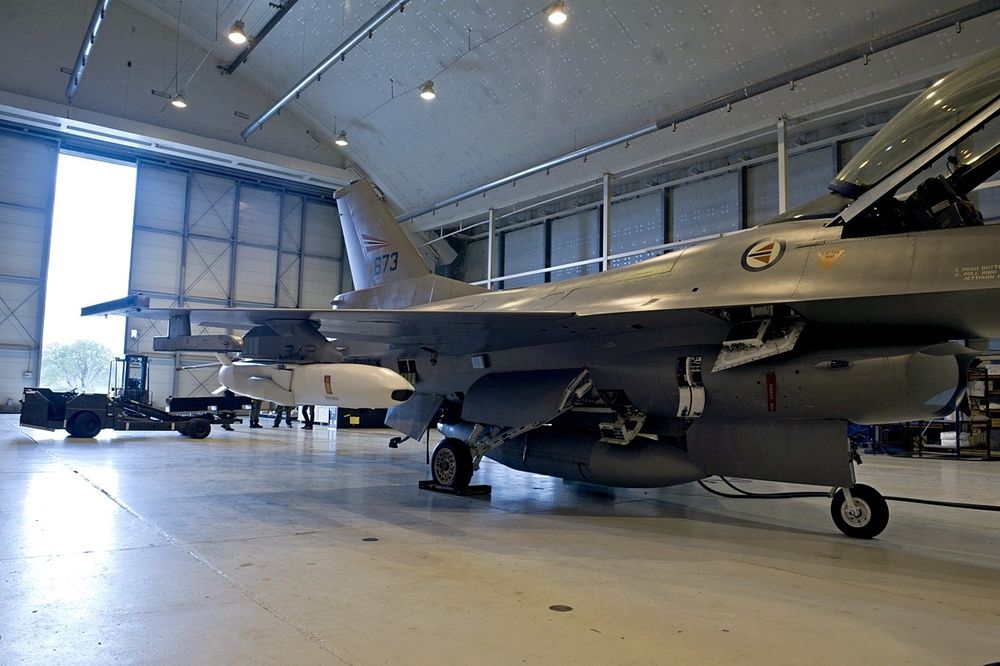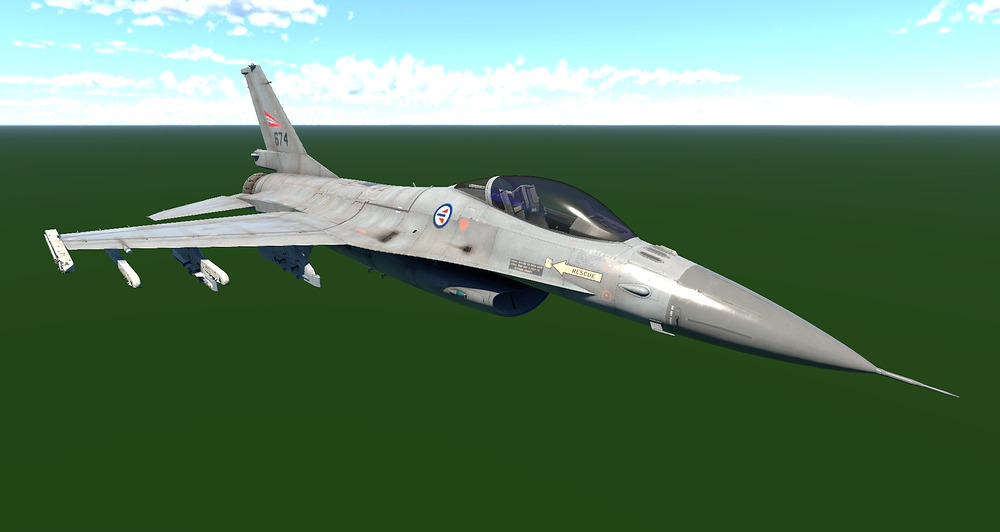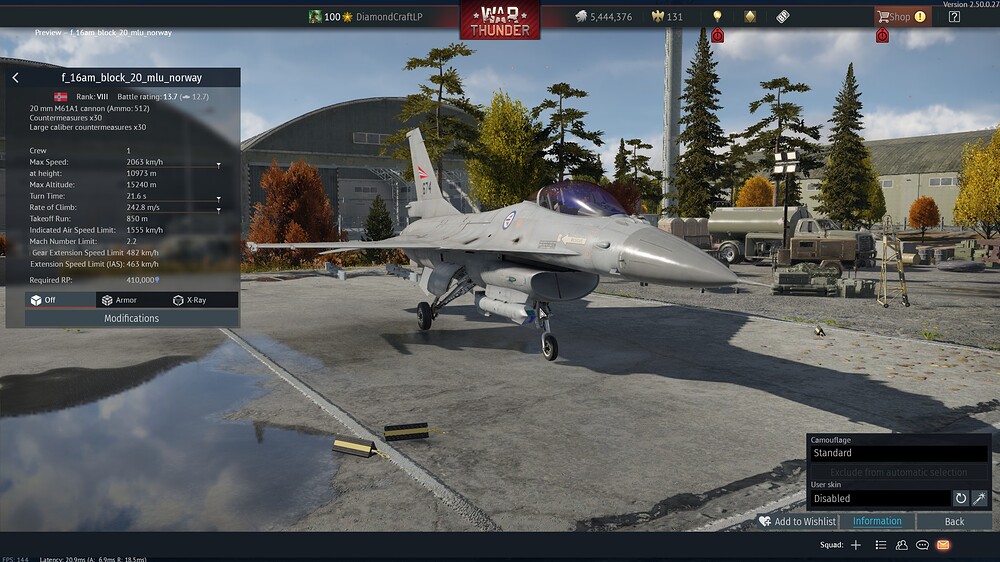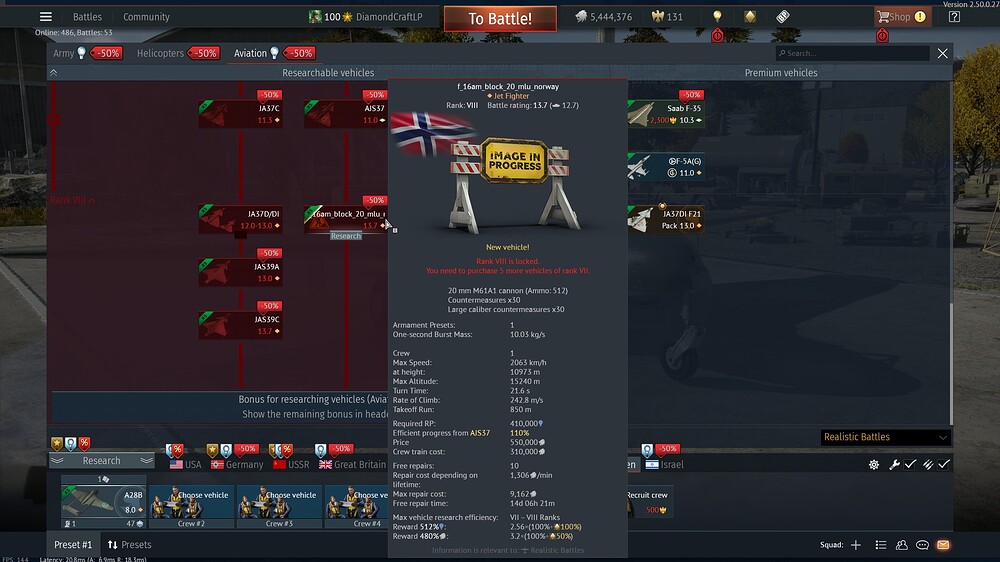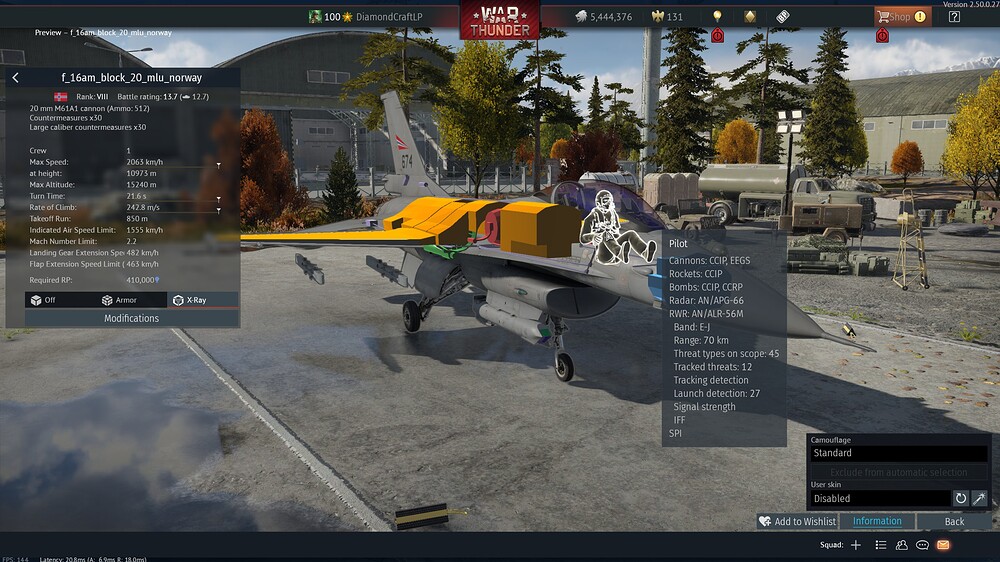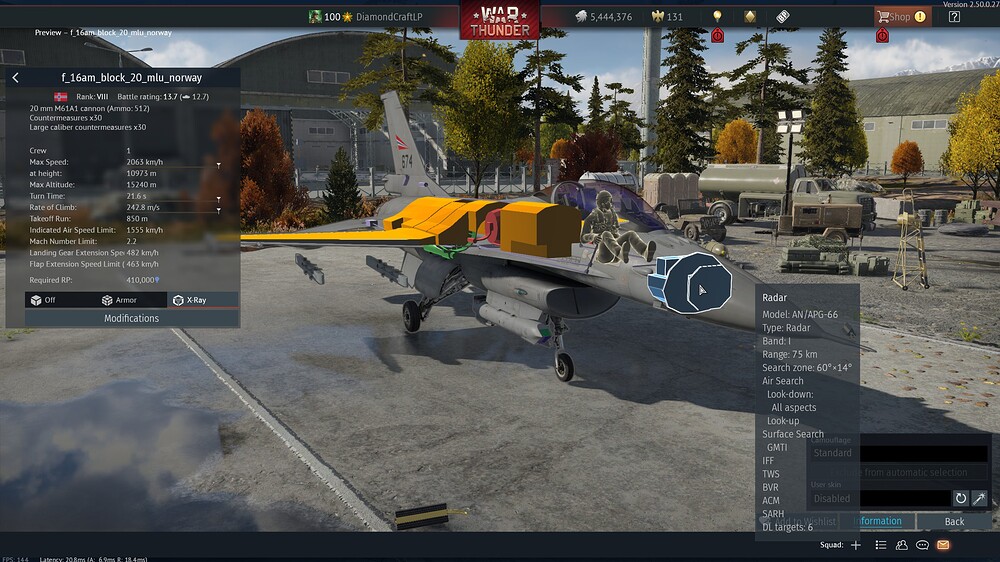
TYPE: One seated multi role fighter
AMOUNT IN NORWEGIAN SERVICE: 58 planes
DESIGNED BY: General Dynamics & Lockheed Martin
CONFIRMED ORDERED/BOUGHT IN: 1975
ENTERED RNoAF SERVICE IN: 15 January 1980
MLU UPGRADE EXECUTED IN: 2000
ARMAMENT
Spoiler
Primary
-
1x M-61A1 20mm cannon
-Ammunition capasity: 500 Rounds -
Internal Countermeasures
-Flares & Chaff 30x
-3x5 clusters
Secondary armament
-
6x IRIS-T Air to air Missiles
-Maximum Overload: 60g at 60°
-Maximum speed: Mach 3
-Weight: 87.4 Kilograms
-Lenght: 2.95 Centimeter
-Diameter: 1.27 Centimeter
-Launch range: 25 Kilometer
-Detonation mechanism: Impact and active radar proximity fuse
-Wingspan: 447 mm
-Guidance system: Infrared homing/radar homing -
4x AIM 120C AMRAAM Air to air Missiles
-Maximum Overload: 28-35g
-Max speed: Mach 4
-Warheads: HE fragmentation
-Navigation system: Active radar
-Max speed: Mach 4
-Length: 3.66 Metres
-Diameter: 178 Millimeter
-Weight: 152 Kilograms -
4x AIM-120B AMRAAM Air to air missiles
Length: 3.65 metres
Diameter: 17.8 centimeters
Mass: 161.5 kilograms
Speed: Mach 4
Range: 74 Kilometers -
4x AIM 9L Sidewinder
-Maximum Overload: 30g
-Maximum speed: Mach 2.5
-Aspect: All aspect
-Weight: 84.46 Kilograms
-launch range: 18km -
4x Aim 9M air to air missiles
Length: 2.87 meters
Body diameter: 127 Millimeters
Wingspan: 0.64 Meters
Launch weight: 87 Kilograms
Warhead: 9.5 Kilogram HE blast fragmentation
Fuze: Active laser
Guidance: IR
Propulsion: Solid propellant
Range: 8 Kilometers -
4x Mk.3 (AGM-119A) Kongsberg Penguin Anti-Ship Missile
-Weight: 370 Kilograms
-Lenght: 3.2 Meter
-Diameter: 28 Centimeter
-Warhead: 130 Kilograms
-Propulsion: Conventional gunpowder engine
-Control system: Heat-seeking
-Max Speed: Subsonic Missile
-Type: Fire and forget missile
-Manufacturer & Developer: Kongsberg Defense Systems -
3x Fuel drop tanks
-Center + wings -
6x GBU-12 Paveway II (Mk 82) laser-guided bombs
-Type: Laser guided bomb
-Mass: 230 kilograms
-Length: 3.27 Meter
-Diameter: 273 Millimeter
-Effective firing range: 14.8 Kilometer -
4x GBU-38 JDAM - Joint Direct Attack Munitions guided bombs
-Span: 356 Millimeters
-Length: 2,352 meters
-Launch weight: 253.6 Kilograms -
4x GBU-32 JDAM - Joint Direct Attack Munitions guided bombs
-Span: 498 Millimeters
-Length: 3,035 metres
-Launch weight: 460.5 Kilograms -
Countermeasures Wingpods
-Flares & Chaff
-120x -
4x GBU-10
-
4x GBU-24 Paveway III
-Diameter: 460 Millimeters
-Length: 4.39 Meters
-Launch weight: 1,050 Kilograms -
GBU-31
-
GBU-39 SDB on BRU-61
Mass: 129 kg
Length: 1.80 m
Width: 1.61m Wings extended
Width: 90 mm Wings packed -
4x 2,000 lb LDGP Mk 84 bombs
-
12x Mk 82 Snakeye (500 lb)
-
12x 500 lb LDGP Mk 82 bomb
NORWEGIAN MODIFICATIONS
-HMD - Helmet Mounted Display
-Greenish and a bit Purple Cockpitglass Tint
-IRIS-T missile
-Amraam missiles
-Guided Bombs
-Sniper Pod
-Drag Chute
-AN/APX-113 IFF
-Datalink
-ALQ-131
-Penguin anti ship missile
TECHNICAL DATA
Wingspan: 10.0m
Lenght: 15.1m
Eigne: Pratt & Whitney F 100-220 E
Speed: 2400 km/h Mach 2.05
Range: 3.230 km
HISTORY
Beyond the 60s, it was clear that Norway would have to look around for a new buyer for the Starfighter, and the process started in earnest in 1970. Together with the NATO countries Denmark, the Netherlands and Belgium, several alternatives were considered; French Mirage F.1, Swedish Saab 37 Viggen and either Northrop F-17 or F-16 from General Dynamics, later Lockheed Martin.
The idea was that everyone should choose the same aircraft type, and the group eventually landed on the¨F-16. In the summer of 1975, Norway ordered a total of 74 aircraft, 60 single-seat F-16A and 12 two-seat F/16B. All were to be built under license at the Fokker/factory in the Netherlands. The deal was referred to as the Flight Purchase of the century.
The first aircraft took to the wings on 12 December 1979. The aircraft were produced in blocks and mini-blocks and were developed along the way. The Norwegian F/16A machines came from the main blocks 1, 5, 10 and 15 and were equipped with F100/PW/220E engines with digital electronic fuel control. Hulls have since been reinforced to extend the life of the aircraft, and the main computer, fire control systems, cockpit equipment, electronic equipment and everything has been replaced or upgraded. The largest of these upgrade programmes, MLU-Mid Life Upgrade, which continued until the turn of the year 2002-2003, resulted in 57 aircraft, F-16A and B, being adapted to the block 15 standard. The Block 10 aircraft received, among other things, new wings and tail surfaces. After this upgrade, the one-seaters received the designation F-16AM and the two-seaters F-16BM. The aircraft’s planned lifetime in the Air Force was thereby extended to 2015. This work was mainly done at Kjeller. In addition, there have been several update programs up to the present day.
332 Squadron became the first detachment to receive the F-16. The squadron had been temporarily closed in 1972, but was re-established on 1 January 1980 as the first F-16 division. It was initially given the status of OTU operational training unit, for both pilots and technical personnel, and was able to take over the first aircraft, the two-seater F-16B 301, on 25 January 1980. The aircraft had arrived in Norway ten days earlier. The first one-seater, 272, did not arrive until the end of April.
However, 331 squadron in Bodø became the first operational department to receive F-16s, and from 1 April 1982 it was operational as a pure F-16 department. Then it was 334 and 336 squadrons’ turn, but after a short time 338 squadron took over the role as the fourth F-16 squadron from 336. From the summer of 1985, all four divisions were equipped with F-16s. during these years a number of planes have been lost, and unfortunately pilots have also died. 57 aircraft are still operational, distributed among 331, 332 and 338 squadrons. Norway has subsequently purchased two replacement aircraft from the USA. The F-16 has become the world’s most sought-after combat aircraft. 4,200 aircraft have been reproduced in more than 110 different versions. approx. 22 countries bought machine. After the fall of the Iron Curtain, Norwegian aircraft have participated in several international actions such as in Yugoslavia, Afghanistan, the Baltics and Libya.
OCU upgrade: 1990
MLU upgrade: 2000
PICTRUES
Spoiler
SOURCES
Spoiler
General Dynamics F-16 Fighting Falcon – Wikipedia
https://www.norli.no/boker/dokumentar-og-fakta/historie-og-dokumentar/krig-og-historie/luftforsvarets-historie-fortalt-gjennom-75-gjenstander?
https://www.adlibris.com/no/bok/norske-militarfly-9788271286873?
Redirecting...
http://www.aviationmuseum.eu/Blogvorm/norsk-luftfartsmuseum/¨
49 år etter den uplanlagte jomfruferden har et nytt F-16 fløyet for første gang | Tu.no
Penguin – Wikipedia
- Yes
- No
Also known as
